Rowdy
Rowdy and the New York Forty Class
Yachting during the 1920s was a glorious and very significant part of American history. It was a time of incredible fortunes and magnificent yachts, a time when high society was the closest thing there was to royalty in America. Such fortunes would diminish in size and number with the introduction of personal income tax in 1917, and the evolution of yachting would wane from larger and faster to smaller and more affordable.
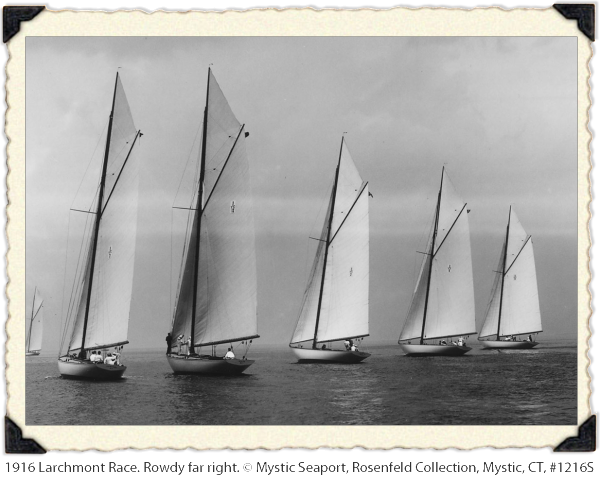
In 1905, Nathanael Herreshoff designed and built eighteen of the one -design class New York 30s for some of the most prominent members of the New York Yacht Club. In 1913, he built and designed nine of the New York 50s. Measuring 70’ on deck, this was the largest class of sizeable one-design boats the world had ever seen. In 1916, he filled the gap between the two, and designed and built twelve of the one -design class New York 40s. (Two more were built in 1926.) The New York 30s, 40s and 50s symbolize the peak of the golden age of yachting. The American Public was enamored with these large yachts, and spectators frequently came out by the hundreds to watch them battle it out for trophies.
The New York 40s (so named because they were built for the New York Yacht Club, and because they measured 40′ at the water line) were 59′ on deck with an additional 6′ of bow sprit, 14’3″ beam and 8′ draft. The 40s were designed to be cruisers with gracious accommodations, and racing was expected to be a secondary consideration. They turned out to be the “hottest racing class of their time called the Fighting Forties because they raced hard all day, and the Roaring Forties for drinking hard all night”(History of the New York Yacht Club, Parkinson, 1975).
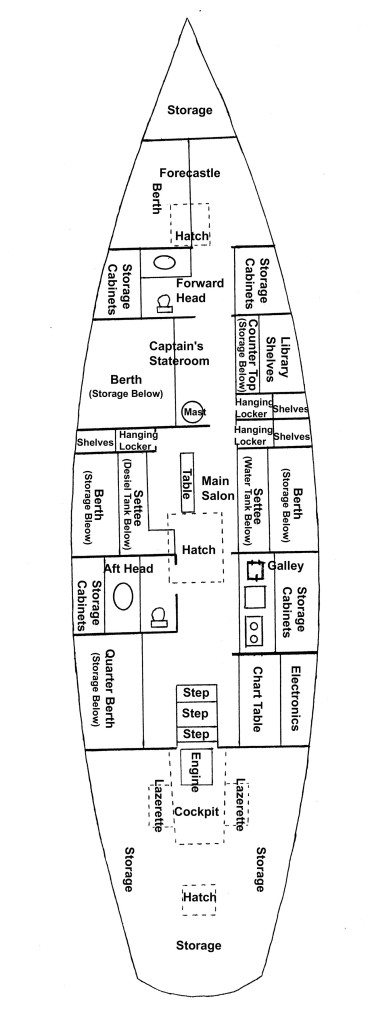 “The Herreshoff 40 foot sloops sailed off the Glen Island course yesterday. Hundreds watched the races from the decks of the many steamers and sailing craft which followed the boats over the course “(N.Y. Times, May 31, 1916)
“The Herreshoff 40 foot sloops sailed off the Glen Island course yesterday. Hundreds watched the races from the decks of the many steamers and sailing craft which followed the boats over the course “(N.Y. Times, May 31, 1916)
“People have said that only Herreshoff could have developed such speed in a boat as wide and roomy as the New York 40, and certainly this has not been done since” (Rudder Magazine 1951).
“Nat Herreshoff has turned out some surprisingly successful yachts but it is doubtful if he ever created a class which has brought so much downright pleasure to the owners as the dozen New York 40′ sloops which he turned out for the New York and Boston yachtsmen” (Rudder Magazine, 1920)
“In the New York 40-footers Herreshoff has probably reached the limit of the type which he had been developing starting with the 57-footers nine years ago” (“Sailing Craft, Shottle, 1937)
” The New York 30s, 40s and 50s have never been bettered for all around sailing excitement and pleasure” (Herreshoff of Bristol, Maynard Bray & Carlton Pinero, 1989).
“After the war there was great racing in this class, considered a baby of the New York Yacht Club fleet”(Seawanhaka Yacht Club1897-1940, Parkinson, 1965).
“The New York 30s, 40 and 50s dominated the New York Yacht club’s 1916 racing season.” (The History of the New York Yacht Club, Parkinsons, 1975)
“It is a perfectly fair statement to say that the six Flying Forties lent to the cruise of the Eastern Y.C. that measure of success which made the event one of the most enjoyable at least from a racing standpoint in the history of the Marblehead organization” (Rudder Magazine, August, 1920)
“The New York Yacht Club forty-footer class will again be an important one in a racing sense during the coming season at Long Island Sound. There will be six of the “roaring forties” taking part in the racing and the sport in that class should be of the usual high standard maintained since these fine vessels left the Herreshoff yards at Bristol almost ten years ago” (New York Times, March 15, 1925)
Holland Sackett Duell placed his order for Rowdy on October 14, 1915 for $10,000 plus $280 for the wheel option instead of a tiller. He took possession and began racing in early May 1916. Her sail was alternatively NY49 or NY9. Holland owned her for almost 25 years (the longest original ownership of any of the New York 40s) and, to this day, Rowdy is the only New York 40 to have never had her name changed. In 2006, after a complete rebuild by Chris Madsen (1998-2004) Rowdy was purchased by Graham Walker who relocated her to the Mediterranean. Under his ownership Rowdy has again become a world class champion, winning in excess of 140 races.
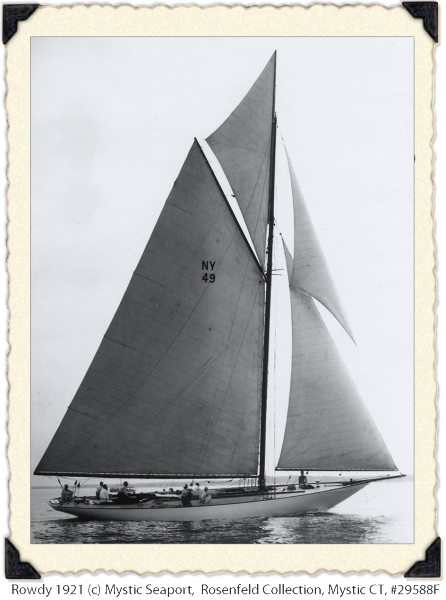
Rowdy Ownership:
1916–1935: Holland Sackett Duell, Milton Point, NY
1936–1940: Emilie Duell, Larchmont, NY
1941: Frank Linden, City Island, NY
1942–1947: Kenneth W. Martin, New York, NY
1948–1950: Frank Zima, Bridgeport, CT (gas engine installed)
1950–1952: George (Red) Stacy, Detroit, MI
1953–1955: Dr. Chaignon Brown, Detroit, MI
1955: Donald Major, Detroit, MI
1955–1963: Aurelian F. Wigle, Detroit, MI (sailed her from Michigan to Florida, accompanied the Winns from Florida to Jamaica)
1963–1971: Frank Winn, Redondo Beach, CA (sailed her to from Florida to California)
1971–1973: John Barkhurst, Redondo Beach, CA
1973–1982: Marvin and Velma C. Stokoe, Oroville, CA
1982–1992: Gerry Purcell, Marina Del Rey, CA
1992–1998: Christy Baxter, La Canada, CA
1998: Blue Whale Sailing School, Santa Barbara, CA
1998–2006: Christopher Madsen, Santa Barbara, CA
2006–2013: Graham Walker, UK
2013–present: Howard Dyer, UK
New York 40s built in 1916:
Black Duck, Arthur K. Bourne – name changed to: Memory
Dolly Bowen, Alexander S. Cochran – name changed to: Cockatoo, Wizard of Bristol
Jessica, Wilson Marshall – name changed to: Sally Ann, Vixen III
Katharine, Aurthur F. Luke
Maisie, Henry B. and M.F. Plant – name changed to: Typhoon
Mistral, George M. Pynchon
Pamparo, James Bishop
Pauline, Oliver G. Jennings – name changed to: Banshee, Chinook
Rowdy, Holland Sackett Duell
Shawara, Harold Wesson (Smith & Wesson guns)
Squaw, John S. Lawrence
Zilph, James E. Hayes, Jr., E. Palmer – name changed to: Marjee
New York 40s built in 1926:
Marilee, Edward L. Cudahy
Rugosa II, R. Grinnell
Surviving New York Forties:
Rowdy (1916) Completely rebuilt and racing actively in the Mediterranean
Chinook (1916) (ex-Pauline) Completely rebuilt and racing actively in the Mediterranean
Vixen II(ex-Jessica) (1916) Wood hull has been replaced with ferro cement. Greatly altered from original. As of 2009 She was in the Mediterranean.
Wizard of Bristol (ex-Dolle Bowen) (1916) Hawaii.
Marilee (1926) Underwent complete rebuild at Cannell Boatyard, Camden, Maine. Racing actively in the Mediterranean
Rugosa II (1926) Actively racing and cruising.
Mistral Yacht Broker Jurek Pielk used to sail on Mistral and last saw her sailing off to Europe under the new ownership of a German around 2002
Lost New York Forties:
Katharine was destroyed in Jacobson boatyard in Oyster Bay. Her yawl rigged spars are now on Rugosa II.
Black Duck, (later Memory), Lee Karol who crewed on Memory reports in 1954 she was owned by Seward De Hart and moored at City Island Yacht Club, New York. In Aug 1954 she tried to sail out of the harbor at Woods Hole MA during hurricane Carol. She hit a sea wall and sank. She was later sold, salvaged and repaired but was lost in a storm off Block Island while returning to New York in 1955
Squaw was purchased by Mr. McNeil of Southport, CT in 1953 from Mr. Chubb of Chubb Insurance in New York. Mr. McNeil renamed her Blue Smoke and sold her in 1968. She sank in 1970 off the entrance to Nassau harbor.
Shawara sank in 1933 off Cape May, New Jersey. Returning home from the Gibson Island race, Shawara encountered a gale and took on water faster than her crew could bail. The crew of seven was picked up by the Standard Oil tanker Yorba Linda.
Maisie (Later Typhoon) Francis Branin Jr. called and informed me that his father owned the boat. In 1959 they were sailing from their home port of Atlantic Highlands NJ to the Oxford MD for winter storage. The boat was lost off Hereford Inlet (north of Cape May)
Pamparo. Mark Andrews wrote to me his great Charles Lee Andrews, a specialist on the floor of the NY stock exchange, bought Pamparo in the twenties for his son Richard Snowden Andrews. He believes that the boat was broken up for lead during WWII.


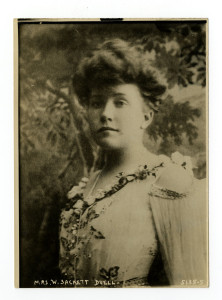
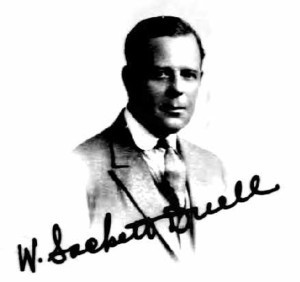
Recent Comments